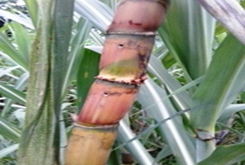Stalk borer
Stalk borer
It was first time recorded from Bengal in year 1905. Fletcher and Ghosh reported it as a pest of sugarcane at Pusa, Bihar. In some parts of Uttar Pradesh, it occurred in epidemic form in 1940. It is one of the most destructive pests of sugarcane crop in subtropical India and a major pest in Uttar Pradesh, Haryana, Punjab and Bihar.
Damage Symptoms
• The larvae feed on plant by scraping the inner surface of these leaf sheaths for a week and they complete two instars.
• Later they mine in one leaf sheath due to which the leaf sheath decays and subsequently the entire leaf dries.
• Due to continuous feeding of larvae leaves show distinct longitudinal orange yellow streaks extending from tip to base on both sides of the midrib towards leaf margins.
• The grownup cane of infested plant does not visible unless the leaf sheaths are removed when the bore holes may be sum clearly on the internodes.
• By splitting of damaged internodes show symptoms of reddening which sometimes emit a rancid odor.
Management
• Detrashing of cane during September-October will expose the infested internodes to the activity of natural enemies.
• Removal of water and late shoots at fortnightly interval.
• Release of Trichogramma chilonis egg parasitoids@50000/ha at 10 days interval from July is useful in reducing the infestation level.
• Conservation of braconid parasitoid Cotesia flavipes help to reduced stalk borer infestation.
• Detrashing followed by application of systemic insecticides, Diamethoate 30EC @ 2lit. /ha or Chlorpyrifos 20 % EC@ 2.5lit. /ha twice during August and September with one month interval would be useful.



